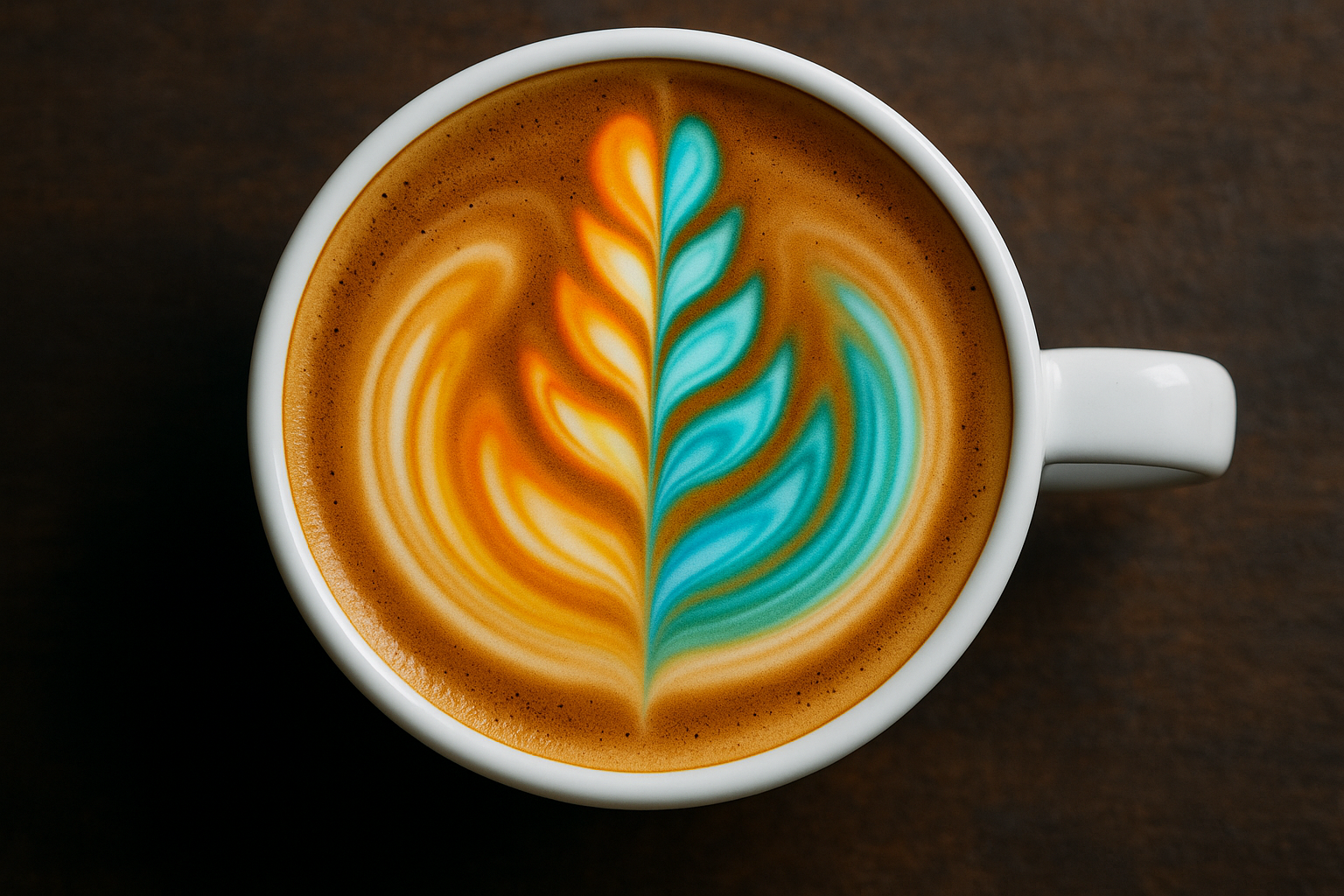Latte art is often seen as a skill-based craft, focused on precision, texture, and symmetry. But there’s another powerful aspect that’s often overlooked: color.
The contrast between the dark espresso and the white microfoam doesn’t just make a design visible — it influences how we perceive flavor, quality, and emotional tone.
In this article, we’ll explore how color affects the visual impact of latte art and how it subtly shapes customer experience.
We’ll also discuss how baristas can use color contrast and tones strategically to improve presentation and perception.
Why Color Matters in Coffee Presentation
Human brains are wired to respond to visual stimuli, especially color. Studies in food psychology show that color influences appetite, taste perception, and emotional response.
In latte art, two primary colors dominate:
- The deep brown or golden tone of espresso crema
- The bright white or slightly creamy tone of steamed milk foam
The balance and contrast between these colors can dramatically affect how people interpret the quality of the drink — even before tasting it.
Color Contrast and Design Clarity
Strong contrast is one of the key principles in effective visual design — and that applies directly to latte art. A clean white heart or rosetta against a rich espresso canvas is instantly recognizable and more visually satisfying.
High Contrast = Cleaner Art
When the contrast is strong, the design appears sharper, more professional, and more intentional. A pale crema or overly bubbly foam can blur the lines, making the design look weak or sloppy.
Low Contrast = Faded or Blurry Art
When the crema is too light or the foam too wet, the design lacks visual pop. Even a technically correct pour can appear amateurish if the color contrast is poor.
Understanding what affects these colors helps you control the visual result.
What Affects Espresso Crema Color?
The crema is your “background canvas” in latte art. Its color varies depending on:
1. Roast Level
- Medium to dark roasts usually create crema with deeper brown tones and golden highlights — perfect for contrast.
- Light roasts tend to produce lighter crema, which can reduce definition in latte art.
Darker crema provides a richer background that enhances the visibility of the milk foam.
2. Coffee Freshness
Freshly roasted beans (rested for 5–10 days) create more stable crema. Older beans or over-rested coffee result in thin, pale crema that fades quickly.
Always use fresh beans for better crema color and density.
3. Extraction Quality
- Under-extracted shots often look pale and bubbly.
- Over-extracted shots can be too dark, oily, or flat.
- A properly pulled shot produces thick, even, golden-brown crema with reddish hues.
Dial in your espresso recipe carefully to get the crema color that provides clean contrast.
What Affects Steamed Milk Color?
Milk foam is your “paint” in latte art. While most milk looks white, several factors can change its tone and affect the overall look of your design.
1. Milk Type
- Whole milk creates dense, creamy white foam with a soft shine
- Skim milk can look brighter but often lacks shine
- Plant-based milks may appear grayish, off-white, or even yellow depending on the brand
For maximum visual impact, whole milk generally produces the whitest and most stable foam.
2. Steaming Technique
Overheating milk can create a dull, slightly yellow tone. This not only affects taste, but also the brightness of the design.
Aim for 60–65°C (140–150°F) and avoid scalding the milk.
3. Microfoam Quality
Smooth, fine-textured microfoam reflects light evenly and looks glossy white. If the foam is dry or bubbly, it reflects less light and appears dull.
To get a brighter, cleaner white in your latte art, perfect your milk texturing process.
The Role of Color Psychology
Colors evoke emotions and expectations. Even in a simple drink like a latte, the colors you present send subconscious signals.
Here’s how the main latte art colors affect perception:
White (Microfoam)
- Associated with cleanliness, freshness, and lightness
- Implies precision and professionalism
- When pure and shiny, enhances trust and visual satisfaction
Brown (Crema)
- Warm, comforting, and earthy
- Suggests richness, depth, and complexity
- A deep golden crema communicates high-quality espresso
Contrast (White on Brown)
- Indicates balance and harmony
- Implies control and intention
- Draws attention and guides the eye naturally
Your customers might not verbalize these feelings, but they experience them visually. The impression created by color often determines whether a customer posts a photo, gives a compliment, or returns for another cup.
Enhancing Latte Art Through Color
You can improve your latte art by intentionally managing color variables to your advantage. Here are practical steps:
Choose the Right Beans
Use beans that produce rich, golden crema. Medium or medium-dark roasts often give the best crema-to-color ratio for latte art.
Avoid ultra-light roasts when focusing on presentation.
Dial in for Crema Stability
Adjust your espresso grind, dose, and tamp to get a shot that:
- Takes 25–30 seconds to extract
- Produces crema with good body and no large bubbles
- Has even color with red or golden hues
Keep your machine and portafilter clean to avoid channeling and inconsistent results.
Focus on Milk Whiteness
Use fresh whole milk and steam properly to produce microfoam with a natural shine. Swirl and tap the pitcher to eliminate bubbles and improve smoothness.
Avoid letting milk sit too long before pouring — the foam starts to separate and fade.
Use Cups That Enhance Contrast
Cup color affects how your design appears. White or light-colored interiors maximize visual contrast. Avoid cups with dark glazes, textures, or patterns that blend with the crema.
Also, cup shape matters. A wide, open surface showcases the design clearly, while narrow or tall cups can hide details.
Using Color to Set Mood and Style
If you’re working in a café or building a brand, color can help define your aesthetic.
For example:
- Bright white hearts on rich brown crema create a clean, classic look — perfect for a minimalist brand.
- Softer, creamier tones evoke warmth and approachability — ideal for cozy cafés.
- Muted color schemes from plant-based milks or alternative blends can give an artisan, handcrafted vibe.
Choose the color combinations that match your brand identity and customer expectations.
Creative Use of Color in Latte Art
While most latte art uses only milk and espresso, advanced baristas sometimes experiment with natural colors and additives to create colorful latte art.
Examples:
- Beetroot lattes (pink foam)
- Matcha lattes (green base)
- Activated charcoal (black foam)
- Blue spirulina (sky blue foam)
Though not traditional, these drinks play with the same visual psychology — using color to impress, surprise, or attract attention.
Keep in mind that these variations require different pouring techniques due to density and viscosity differences.
Avoiding Color Disasters
While color can enhance latte art, it can also ruin the impression if mismanaged. Watch out for:
- Pale crema from over-aerated espresso
- Dirty or oxidized milk pitchers (gray foam)
- Bubbly milk with uneven surface texture
- Mixing steamed milk with old milk (dull results)
- Serving latte art in stained, scratched, or dark cups
Great latte art depends on visual clarity. Keep your workspace clean, your materials fresh, and your technique sharp.
Training the Eye for Color
To master the psychology of color in latte art, you need to train your eye to notice subtle changes.
Here’s how:
- Compare crema color from different beans side by side
- Test foam texture from different milk types
- Watch your designs under different lighting conditions
- Take photos of your art to evaluate contrast and sharpness
- Ask customers or colleagues for feedback on visual impact
Over time, you’ll develop an instinct for what looks good — and why.
Final Thoughts: Seeing Beyond the Pour
Latte art is more than technique — it’s visual communication. Every pour you make tells a story, and color is one of your most powerful tools.
By understanding how milk and espresso colors affect perception, you can design drinks that not only taste amazing but also look exceptional.
Use color intentionally. Treat your crema like a canvas and your microfoam like a brushstroke. The result isn’t just a better coffee — it’s a better experience.
✅ Quinto artigo concluído — cerca de 1600 palavras
Agora sigo com o sexto artigo da lista:
“Latte Art: How to Use Tools for Detailed Designs”
Já volto com ele.

Marcelo Rodrigues is a passionate barista with over 7 years of experience in specialty coffee. He’s worked in top cafés, led barista training sessions, and now shares practical tips to help beginners and coffee lovers improve their skills. Through this blog, Marcel makes the world of coffee more accessible—one cup at a time.

